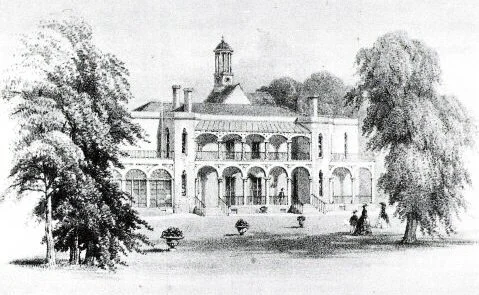Saint Wilfrid Church Heritage
CHURCH HISTORY SAINT WILFRID’S LEGACY CLERGY OF THE PARISH MEMORIALS THE WAR YEARS IN SEARCH OF SAINT WILFRID
A brief history by Peter Green and John Hawkins
The Local legacy of saint wilfrid
Wilfrid (634-709) is one of the greatest and also one of the most controversial English Saints. He directly influenced the move away from Celtic to the more orderly Roman church practices and is best known for championing and winning the case for the Roman, as opposed to the Celtic method of calculating the date of Easter at the famous Synod of Whitby in 664.
He became Bishop of York with a See covering the whole of Northumbria, built magnificent stone churches at Ripon and Hexham. He acquired vast landholdings and established monasteries in Northumbria, Mercia, Sussex and the Isle of Wight and converted Sussex, the last vestige of paganism, to Christianity.
He was the confidant of kings and queens but made many powerful enemies and was twice banished from Northumbria. He made three journeys on foot and horseback through Europe to Rome and was not afraid to seek papal jurisdiction over both crown and church where he felt badly treated. His life was threatened many times being shipwrecked and nearly killed by natives off the coast of Sussex, imprisoned in Northumbria by the king and twice nearly murdered whilst travelling abroad.
681 Selsey (Church Norton)
When Wilfrid was banished from Northumbria in 680 he travelled south seeking the protection of first Mercia and then Wessex royal households but was subsequently banished from each as a result of blood line connections of the royal families back to the Northumbrian crown.
Finally Wilfrid travelled to Sussex and fortunately was welcomed by king Aethelwealh of the South Saxons who presented to Wilfrid an estate of eighty seven hides to form a monastery at Selsey – which in Latin [Insula Vituli Marini] means ‘the island of the seal’.
In 681 Wilfrid became the 1st Bishop of Selsey and the cathedral seat remained at Selsey until bishop Stigand c 1076 when it was moved to its present site in Chichester.
The present St. Wilfrid’s Chapel at Church Norton is the 13th century chancel of a large Norman church that is thought to be located very close to Wilfrid’s original monastery and church. The main part of the current church was removed in 1864 and rebuilt in the centre of Selsey as St. Peter’s church to serve the growing population of this seaside resort.
686 King Caedwalla Charter – Hundred of Pagham
Caedwalla, an exiled son of king Centwine of Wessex, was befriended and helped by Wilfrid c681 and in 685 with a band of lawless followers Caedwalla ravaged Sussex and killed king Aethelwealh before being repulsed. In 686 after becoming king of Wessex he finally subdued the South Saxons and went on to ravage Kent and then the Isle of Wight (he gave a quarter of the island to Wilfrid).
In 686 king Caedwalla issued a charter confirming the rights and territories previously given to Wilfrid by king Aethelwealh and the estate of the Hundred of Pagham including Shripney, Charlton, Bognor, Bersted, Crimsham, Mundham and Tangmere.
The handing over of the charter is brilliantly depicted in the Lambert Barnard mural in the south transept of Chichester Cathedral commissioned by Bishop Robert Sherburne (bishop 1508-1536) in the 1530s.
Note: Photograph taken and reproduced with the kind permission of the Dean and Chapter of Chichester Cathedral and no reproduction of these photographs is permitted without their permission
686 St. Andrew’s, Pagham
The Caedwalla charter mentions ‘his [Wilfrid’s] brethren serving God at the church of St. Andrew on the eastern shore of the harbour’ and it is presumed that the remains are next to vicarage of the present church of St. Thomas a Becket, Pagham. The remains are limited to part of the wall between the nave and the chancel and are in are in the garden of Little Welbourne which was built c1706. St. Andrews was secularised in 1626 and ended up being used as a garage.
11th Century Thomas a’ Becket Parish Church, Pagham
The current parish church of Pagham, St. Thomas a Becket dates mainly from the 13th century with 11th century fragments dating from just a few years of Becket’s martyrdom.
Fragments of an Anglo Saxon church found under the church’s foundations are in display in the South Transept.
13th Century St. Bartholomew, Bognor
The site in Bognor of this very early chapel of the parish church of Pagham is not known and was standing unserved as long ago as 1384. Lindsey Fleming in his History of Pagham states that in 1317 there was an instruction from the Archbishop that the10th July in each year was to be remembered as the dedication festival of Pagham church. In 1538 there was correspondence between the vicar of Bersted and the Prior of Canterbury where the Prior stated that the chapel fell into the sea along with many houses 18 -20 years earlier i.e. about 1520.
13th Century St. Mary Magdalene, South Bersted
Bersted was originally a chapel of Pagham and the church of St. Mary Magdalene is mainly13th century including the tower. It was styled a parish church by 1465 including Bognor.
1793 Chapel of St. Alban
Sir Richard Hotham built a chapel of St. Alban in Chapel House (later known as Bersted Lodge and now Hotham Park House). After J.B. Fletcher bought the house in 1857 he had the chapel demolished.
1822 St. John’s Chapel Built in the Steyne
In 1821 a Bognor builder Daniel Wonham erected as a speculation a chapel of ease St. John the Evangelist in the Steyne.
On Friday 25th January 1822 the Service of Consecration and Dedication of the Chapel of Ease in the Hamlet of Bognor was conducted by his Grace, Charles Manners Sutton, Archbishop of Canterbury (Bp of Norwich 1792, AB Canterbury 1805-28).
The shield which bears his coat of arms and the shield bearing the Royal Coat of Arms, were donated by Thomas Smith of Bersted. After the demolition of the chapel the shield was transferred to the west wall of St. John’s church in London Road and now hangs above the west door entrance to the porch in St. Wilfrid’s church.
1833 Gothic Tower added to St. John’s Chapel
A Gothic style tower was added complete with castellated parapet and pointed-arch window and this became a feature of Bognor’s skyline.
The tower contained a clock and 4cwt bell named “Mary Ann” which had been donated by the Rev Charles and Miss Baumgarten of Aldwick at a cost of £200. Miss Baumgarten also donated a weather vane for the tower and a Captain S H Baumgarten a bible and prayer book for the reading desk.
The Old Testament part of the 1833 bible was rediscovered in April, 2007 and has now been refurbished. The New Testament section was discovered in May 2008.
In Fleming’s ‘History of Pagham’, regarding old St. John’s, it states – ‘The tower was added by the liberal aid of the Rev. Charles Baumgarten, also the belfry and tower clock; his sister, Miss Baumgarten, giving £25 towards the handsome vane surmounting the tower’. This confirms that Miss Baumgarten was the Rev. Charles’s sister. In the IGI there is a reference to Mary Anne Charlotte Baumgarten, daughter of Samuel Henry Baumgarten and Ann was baptised at Petworth on 21st August 1805.
The relationship of Captain Samuel Henry Baumgarten to the Rev. Charles Baumgarten and his sister Mary Ann has yet to be identified.



1873 St. John’s in the Steyne upgraded from Chapel to Church
As a result of the increase in the local population, Bognor was granted parish status, independent of South Bersted, in February 1873. St. John’s was upgraded from chapel to Parish Church.
1876 Report – Requirements for a larger Church
It was decided a larger church was necessary and a report in May 1876 stated that enlargement of the existing St John’s was not feasible. Its walls were too thin and, more to the point, the church was bounded east and west by roads.
1880 Cottage Mission Room, North Bersted
The building. formerly a blacksmith’s cottage, was licensed for Diocesan services in 1880.
1880 Foundation Stone – St. John’s Church, London Road
A foundation stone was laid by Lady Cecilia Bingham, youngest sister of the Duke of Richmond and Gordon, on 25 August 1880 in Dorset Gardens, now called London Road for a new St John’s church. Within two years the church was complete with the exception of the tower. The architect was Sir. Arthur William Blomfield (1829-1899)
1886 Consecration of St. John’s Church, London Road
St John’s church in London Road consecrated by the Lord Bishop of Chichester in January 1886.



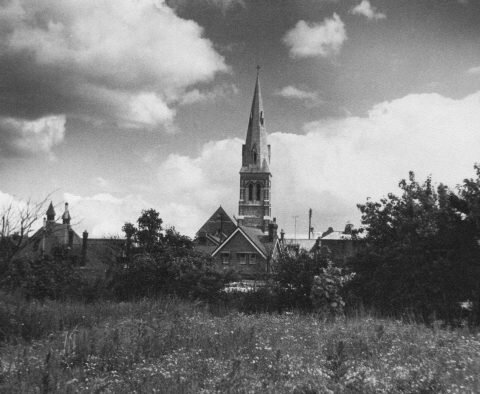


In 1895 the spire was completed at St John’s church, London Road
Photographs of St. John’s Church in London Rd. by kind permission of James Clevett (01903 714922)
1891 Plans for St. Wilfrid’s Church
There has for some time been talk of a new church to supply the growing necessities of the west end of Bognor, and we hear that all the preliminaries are now settled and that immediate steps will be taken to carry it out. (‘From our Files’ – 100 years ago – Bognor Regis Observer 25/ 7/1991)
1891-2 Demolition of St. John’s Church in the Steyne
St John’s church in the Steyne carried on with its regular services until its demolition in 1891-2. The rubble remnants were sold to a builder, Mr Southerton, who used the material for erecting St John’s Terrace in Highfield Road. The clock tower however, remained as a landmark for the local fishermen.
1894 Holy Cross Mission Church, North Bersted
A new mission church replaced the Cottage Mission Room in 1894. The spire was removed for safety reasons in April 1976.
Saint Wilfrid Church, Bognor
1896 Tin Chapel, Victoria Drive
1908 Stone Laying of St. Wilfrid’s Church
1910 Dedication of St. Wilfrid’s Church
1955 consecration of St. Wilfrid’s Church
1971 Parish Church of Bognor Status granted to St. Wilfrid’s Church
Saint Wilfrid Church was only partially completed at a cost of £8,200. The tower, spire, three bays of the nave and baptistry were still missing, are still are to this day.
For more information about the development of Saint Wilfrid Church, please click on the following button.
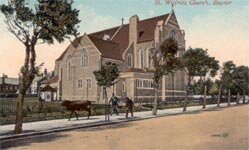


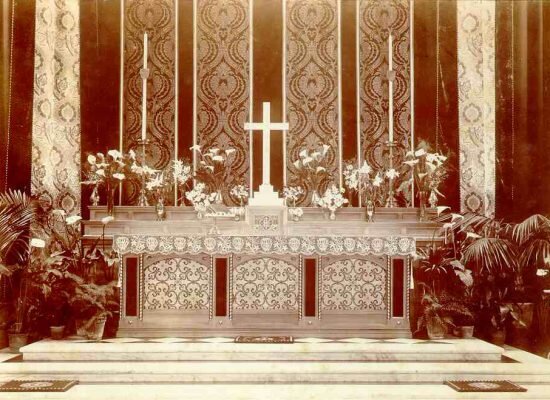

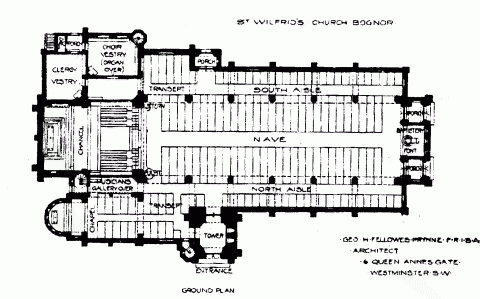
1919 The Reredos Design by F.G. Howard for St. John’s Church
The reredos was erected as a war memorial by public subscription following a faculty application 24 April, 1919 by H.J. Clayton, vicar of Bognor.
The figures represent from left to right St George for soldiers, St. Joan of Arc for women and France, St. Nicholas for sailors, Centre Panel of the Transfiguration, The Baptist for the church dedication, St. Mary Magdalene for the mother church in South Bersted and St. Wilfrid for the daughter church (as it was then) in Victoria Drive.
Note the centre panel was changed in 1934 and the reredos was moved to St. Wilfrid’s church in 1971 before St. John’s church was demolished.
1952 Chime of 8 Bells for St. John’s Church
A chime of 8 bells by Gillett & Johnson dated 1952
1960 Clock Tower of St. John’s Church in the Steyne Demolished
The remaining clock tower of the St John’s Church in The Steyne was demolished and the site used for a car park.
1971 Closure of St. John’s Church, London Road
The last service was held in St. John’s church in May 1971. The church was demolished in 1972 and the site sold in March 1973 to make way for the present WH Smith and Boots stores.


